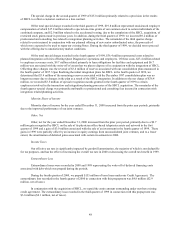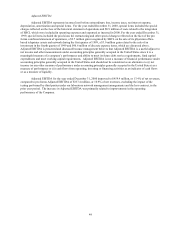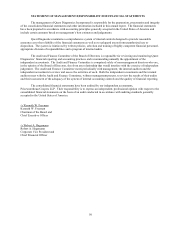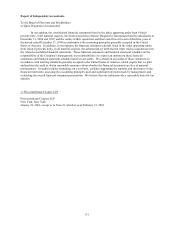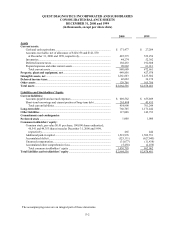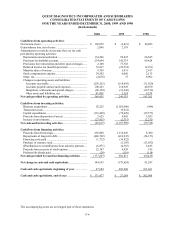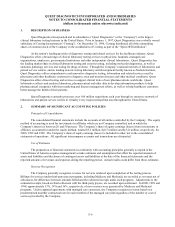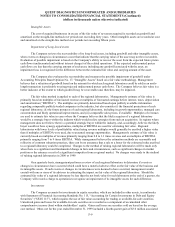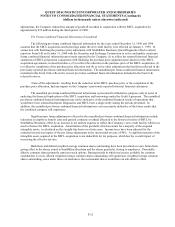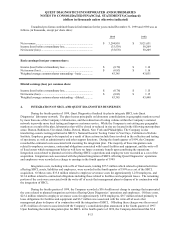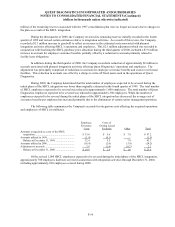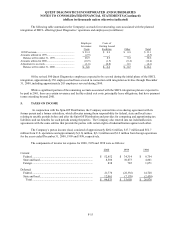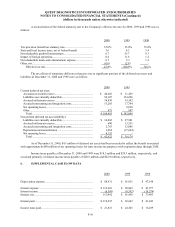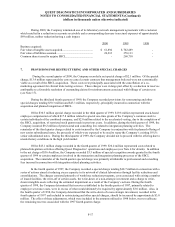Quest Diagnostics 2000 Annual Report Download - page 78
Download and view the complete annual report
Please find page 78 of the 2000 Quest Diagnostics annual report below. You can navigate through the pages in the report by either clicking on the pages listed below, or by using the keyword search tool below to find specific information within the annual report.QUEST DIAGNOSTICS INCORPORATED AND SUBSIDIARIES
NOTES TO CONSOLIDATED FINANCIAL STATEMENTS (Continued)
(dollars in thousands unless otherwise indicated)
F-8
Stock-Based Compensation
Statement of Financial Accounting Standards No. 123, “Accounting for Stock-Based Compensation” (“SFAS
123”), encourages, but does not require, companies to record compensation cost for stock-based compensation plans at
fair value. The Company has chosen to continue to account for stock-based compensation using the intrinsic value
method prescribed in Accounting Principles Board Opinion No. 25, “Accounting for Stock Issued to Employees” (“APB
25”), and related interpretations.
Foreign Currency
Assets and liabilities of foreign subsidiaries are translated into U.S. dollars at year-end exchange rates. Income
and expense items are translated at average exchange rates prevailing during the year. The translation adjustments are
recorded as a component of accumulated other comprehensive income (loss) within stockholders’ equity. Gains and
losses from foreign currency transactions are included in consolidated income. Transaction gains and losses have not
been material.
Cash and Cash Equivalents
Cash and cash equivalents include all highly-liquid investments with maturities, at the time acquired by the
Company, of three months or less.
Concentration of Credit Risk
Financial instruments that potentially subject the Company to concentrations of credit risk are principally cash,
cash equivalents, short-term investments and accounts receivable. The Company’s policy is to place its cash, cash
equivalents and short-term investments in highly rated financial instruments and institutions. Concentration of credit risk
with respect to accounts receivable is mitigated by the diversity of the Company’s clients and their dispersion across
many different geographic regions, and is limited to certain customers who are large buyers of the Company’s services.
To reduce risk, the Company routinely assesses the financial strength of these customers and, consequently, believes that
its accounts receivable credit risk exposure, with respect to these customers, is limited.
Inventories
Inventories, which consist principally of supplies, are valued at the lower of cost (first in, first out method) or
market.
Property, Plant and Equipment
Property, plant and equipment are recorded at cost. Major renewals and improvements are capitalized, while
maintenance and repairs are expensed as incurred. Costs incurred for computer software developed or obtained for
internal use are capitalized for application development activities and expensed as incurred for preliminary project
activities and post-implementation activities. Capitalized costs include external direct costs of materials and services
consumed in developing or obtaining internal-use software, payroll and payroll related costs for employees who are
directly associated with and who devote time to the internal-use software project and interest costs incurred, when
material, while developing internal-use software. Capitalization of such costs ceases when the project is substantially
complete and ready for its intended purpose. Certain costs, such as maintenance and training, are expensed as incurred.
The Company capitalizes interest on borrowings during the active construction period of major capital projects.
Capitalized interest is added to the cost of the underlying assets and is amortized over the useful lives of the assets.
Depreciation and amortization are provided on the straight-line method over expected useful asset lives as follows:
buildings and improvements, ranging from ten to thirty years; laboratory equipment and furniture and fixtures, ranging
from three to seven years; leasehold improvements, the lesser of the useful life of the improvement or the remaining life
of the building or lease, as applicable; and computer software developed or obtained for internal use, ranging from three
to five years.


